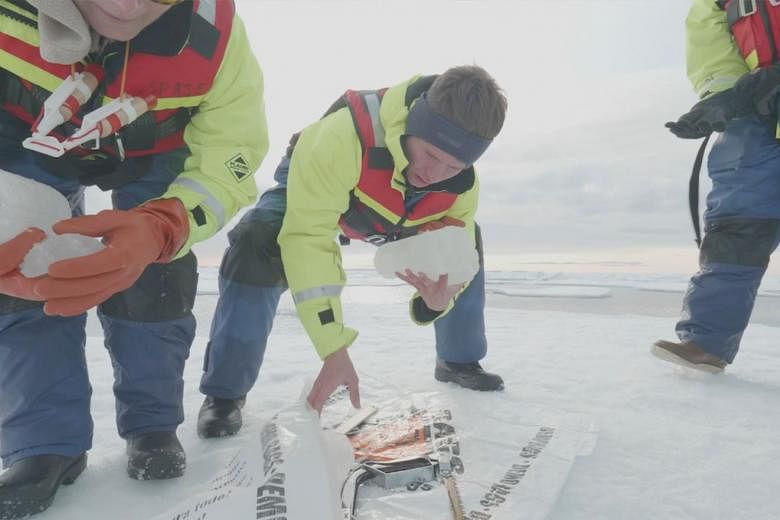BERLIN • Scientists say they have found an abundance of tiny plastic particles in Arctic snow, indicating that microplastics are being sucked into the atmosphere and carried long distances to some of the remotest corners of the planet.
The researchers examined snow collected from sites in the Arctic, northern Germany, the Bavarian and Swiss Alps, and the North Sea island of Heligoland through a process specially designed to analyse their samples in a lab.
"While we did expect to find microplastics, the enormous concentrations surprised us," said Dr Melanie Bergmann, a researcher at the Alfred Wegener Institute in Bremerhaven, Germany, and co-author of the paper.
The findings were published on Wednesday in the journal Science Advances.
Previous studies have found microplastics in the air of Paris, Teheran and Dongguan in China.
The research demonstrated that the plastic fragments may become airborne in a way similar to dust, pollen and fine particulate matter from vehicle exhaust.
Microplastics come from various sources. Defined as pieces smaller than 5mm, they can be bits of plastics from consumer goods broken down by sunlight and wave action in the oceans; microbeads used in cosmetics and laundry detergents, paint or varnish fragments; tyre dust and microfibres from clothing.
While there is growing concern about the environmental impact of microplastics, scientists have yet to determine what effect, if any, the minute particles have on humans or wildlife.
Dr Bergmann said the highest concentrations of microplastics were found in the Bavarian Alps, with one sample having more than 150,000 particles per litre of melted snow.
Although the Arctic samples were less contaminated, the third highest concentration in the samples analysed - 14,000 particles per litre - came from an ice floe in the Fram Strait off eastern Greenland.
On average, the researchers found 1,800 particles per litre in the samples taken from that region.
Dr Martin Wagner, a biologist at the Norwegian University of Science and Technology who was not involved with the study, said the extremely high concentrations could be partly attributed to the methods the researchers used, which let them identify microplastics as tiny as 11 micrometres, or 0.011mm - less than the width of a human hair.
"This is significant because most studies so far have looked at much larger microplastics," Dr Wagner said. "Based on that, I would conclude that we very much underestimate the actual microplastics levels in the environment.
"Importantly, the study demonstrates that atmospheric transport is a relevant process moving microplastics around, potentially over long ranges and on a global scale."
He added: "Snow may be an important reservoir storing microplastics and releasing it during snow melt, something that has not been looked at before."
The study suggested that the airborne distribution of microplastics has been neglected as a source of contamination and should be accounted for in standard air pollution monitoring schemes.
"We need to know what effects microplastics have on humans, especially if inhaled with the air that we breathe," Dr Bergmann said.
In a separate study, a US-led team of researchers also found plastic in ice cores drilled in the Arctic.
The researchers used a helicopter to land on ice floes and retrieve the samples during an 18-day icebreaker expedition through the Northwest Passage, the hazardous route linking the Pacific and Atlantic oceans.
"We had spent weeks looking out at what looks so much like pristine white sea ice floating out on the ocean," said University of Rhode Island graduate student researcher Jacob Strock, who conducted an initial onboard analysis of the cores.
"When we look at it up close and we see that it's all very, very visibly contaminated, when you look at it with the right tools - it felt a little bit like a punch in the gut," he told Reuters by phone on Wednesday.
The team drew 18 ice cores of up to 2m long from four locations, and saw visible plastic beads and filaments of various shapes and sizes.
"The plastic just jumped out in both its abundance and its scale," said Dr Brice Loose, an oceanographer at the University of Rhode Island and chief scientist of the expedition, known as the Northwest Passage Project.
ASSOCIATED PRESS, REUTERS


